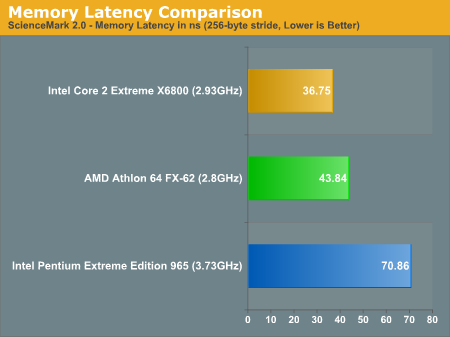Intel's Core 2 Extreme & Core 2 Duo: The Empire Strikes Back
by Anand Lal Shimpi on July 14, 2006 12:00 AM EST- Posted in
- CPUs
Memory Latency: No Integrated Memory Controller Necessary
One thing we pointed out in our earlier preview coverage of Intel's Core 2 Extreme is that the new processors have extremely low latency memory access, despite relying on the same memory controller as the previous generation of Intel CPUs.
Without an on-die memory controller Intel's Core 2 processor must use the memory controller in its chipset, which currently means the 128-bit DDR2 memory controller in either Intel's 965 or 975X chipset. The confusing thing is that although the Core 2 processors use the same memory controller as the old NetBurst processors, memory latency has been improved tremendously:

Intel's Core 2 processors now offer even quicker memory access than AMD's Athlon 64 X2, without resorting to an on-die memory controller. While Intel will eventually add one, the fact of the matter is that it's simply not necessary for competitive memory performance today thanks to Intel's revamped architecture. Update:As many astute readers have pointed out, Core 2's prefetchers are able to work their magic with ScienceMark 2.0, which results in the significant memory latency advantage over AMD's Athlon 64 FX-62. This advantage will not always exist; where it doesn't, AMD will continue to have lower latency memory access and where it does, Intel can gain performance advantages similar to what ScienceMark 2.0 shows.
| CPU | Everest |
CPU-Z 1.35 (8192KB, 128-byte stride) | CPU-Z 1.35 (8192KB, 64-byte stride) |
| AMD Athlon 64 FX-62 (2.8GHz) | 45.9 ns | 43.2 ns | 19.3 ns |
| Intel Core 2 Extreme X6800 (2.93GHz) | 59.8 ns | 52.8 ns | 10.9 ns |
Because of the Core 2's intelligent prefetchers doing too good of a job with ScienceMark memory latency test, we wanted to also showcase situations where Core 2 would feature slower memory accesses than the AMD platform with its integrated memory controller. Everest's results are more in line with what we'd expect to see, with the FX-62 offering over 23% faster memory accesses than the X6800. CPU-Z's latency tool also reported somewhat similar findings, with an 18% performance advantage due to AMD's integrated memory controller. CPU-Z also provided us with numbers that showcase how well Core 2 can perform if its prefetchers are able to "guess" correctly; at lower strides the Core 2 Extreme manages faster memory access than the FX-62. The 128-byte stride numbers are indicative of what will happen if the pre-fetchers are not able to get the Core 2 the data it needs, when it needs it, while the 64-byte numbers show you what can happen when things go well.










202 Comments
View All Comments
Gary Key - Friday, July 14, 2006 - link
The first nF4 Intel Edition boards will be available the week of 7/20. The nForce 500 boards for Intel will not be available until early August. We are now under NDA for the nForce 500 until NVIDIA makes their release announcement. However, there are a couple of nForce 500 boards that look very promising at this time. Do not expect high FSB overclocking results until NVIDIA's next chipset but overall performance is very good at this time.mobutu - Friday, July 14, 2006 - link
Thank you very much for the info you shared.Still, one more question: what do you mean "nVidia next chipset"? Like nF6 or smtg? Because if so it means probably Q4 2006 or Q1 2007 ...
Gary Key - Friday, July 14, 2006 - link
The one that will come out this winter that we cannot discuss except for the fact that it will be a single chip and dual x16 capable. :) Of course, no real mention of it so far but ATI has a really nice Intel chipset due in late August to early September followed up by a refresh in the winter also.mobutu - Friday, July 14, 2006 - link
Oh, I got it. Thank you very much, much appreciated.Looking forward to see Anandtech review of Conroe motherboards.
Visual - Friday, July 14, 2006 - link
you really need to include scores for 4ghz conroes, and maybe some 3.2ghz x2s(though this isnt really needed) and your review will be the most perfectest one evar!JarredWalton - Friday, July 14, 2006 - link
We generally reserve overclocking scores for articles specifically looking at that aspect. It's unfair to include OC'ed Core 2 without OC'ed X2, FX, etc. I hope to get a Core 2 in the near future to run some specific OC benchmarks comparing a lower end (E6300 and/or E6600) Core 2 with X2 3800+ (hopefully EE, but we'll see).junior1 - Saturday, July 15, 2006 - link
Jarred that would be great to see. The E6300 and X2 3800+ seem close, but the final AMD pricing and the overclocking potential of each could really make either the clear winner for performance per dollar in the midrange segment.
Is the die size smaller on E6300 and E6400, or is it a full die with half the cache disabled? Any chance the smaller cache means better OC potential?
It would be great to see results with several chipsets.
Warder45 - Friday, July 14, 2006 - link
awww. At least give us a taste, maybe 2 or 3 of the most CPU intensive tests run at 4ghz.Gary Key - Friday, July 14, 2006 - link
Just wait a few days.... :)mendocinosummit - Friday, July 14, 2006 - link
Ya, that is what I was hoping for. I want to see a dual core (that has some balls, unlike the preslers) run at 4ghz and do some benchmarks